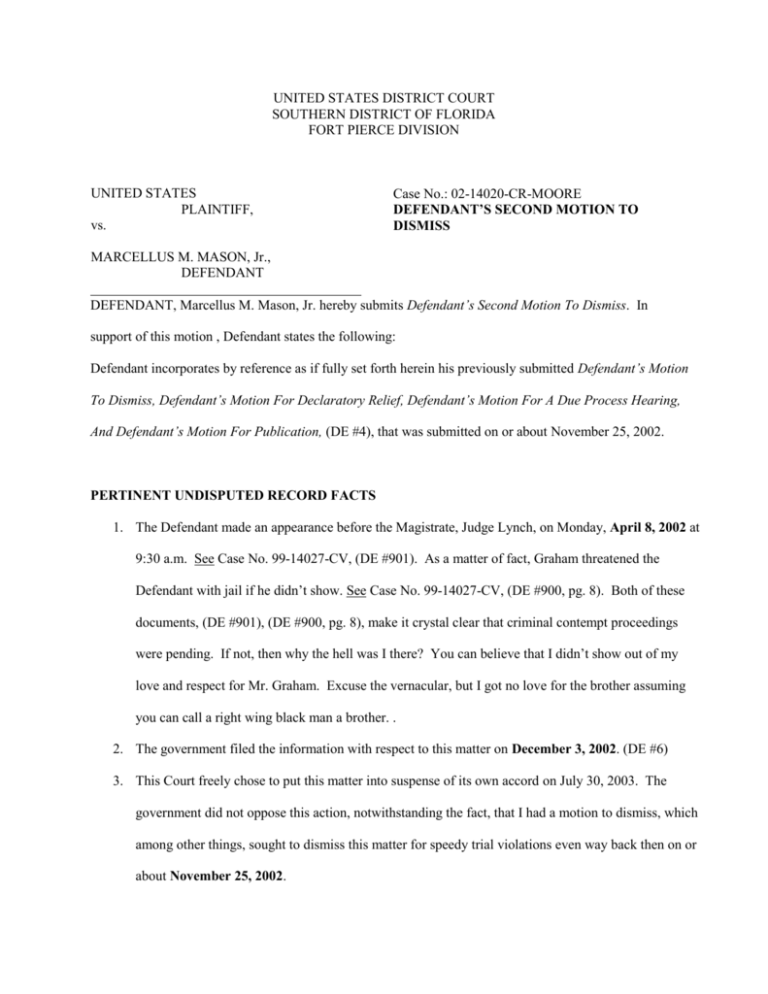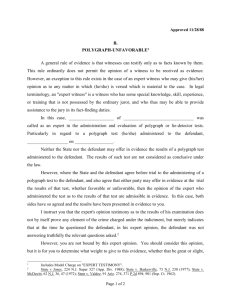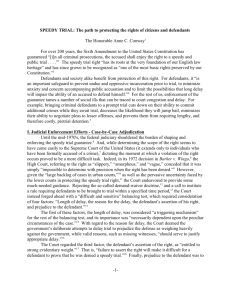SecondMotionToDismis.. - Judge Donald L. Graham
advertisement

UNITED STATES DISTRICT COURT SOUTHERN DISTRICT OF FLORIDA FORT PIERCE DIVISION UNITED STATES PLAINTIFF, vs. Case No.: 02-14020-CR-MOORE DEFENDANT’S SECOND MOTION TO DISMISS MARCELLUS M. MASON, Jr., DEFENDANT DEFENDANT, Marcellus M. Mason, Jr. hereby submits Defendant’s Second Motion To Dismiss. In support of this motion , Defendant states the following: Defendant incorporates by reference as if fully set forth herein his previously submitted Defendant’s Motion To Dismiss, Defendant’s Motion For Declaratory Relief, Defendant’s Motion For A Due Process Hearing, And Defendant’s Motion For Publication, (DE #4), that was submitted on or about November 25, 2002. PERTINENT UNDISPUTED RECORD FACTS 1. The Defendant made an appearance before the Magistrate, Judge Lynch, on Monday, April 8, 2002 at 9:30 a.m. See Case No. 99-14027-CV, (DE #901). As a matter of fact, Graham threatened the Defendant with jail if he didn’t show. See Case No. 99-14027-CV, (DE #900, pg. 8). Both of these documents, (DE #901), (DE #900, pg. 8), make it crystal clear that criminal contempt proceedings were pending. If not, then why the hell was I there? You can believe that I didn’t show out of my love and respect for Mr. Graham. Excuse the vernacular, but I got no love for the brother assuming you can call a right wing black man a brother. . 2. The government filed the information with respect to this matter on December 3, 2002. (DE #6) 3. This Court freely chose to put this matter into suspense of its own accord on July 30, 2003. The government did not oppose this action, notwithstanding the fact, that I had a motion to dismiss, which among other things, sought to dismiss this matter for speedy trial violations even way back then on or about November 25, 2002. 4. This Court did not set this matter for trial until January 30, 2004, (DE #’s 13, 14), or some 423 days after the information was filed on December 3, 2002. HERE IS THE LAW SAYS: THE INFORMATION ITSELF WAS UNTIMELY “Any information or indictment charging an individual with the commission of an offense shall be filed within thirty days from the date on which such individual was arrested or served with a summons in connection with such charges.” 18 U.S.C. §3161(b). The record clearly establishes that the Defendant was summoned to court under the threat of an arrest on Monday, April 8, 2002 at 9:30 a.m. See Case No. 9914027-CV, (DE #901). As a matter of fact, Graham threatened the Defendant with jail if he didn’t show. See Case No. 99-14027-CV, (DE #900, pg. 8). In fact were this appearance not a mandatory summons, I would not have came at all. The information in this matter was not filed until December 3, 2002, or 239 days after I was summoned to court on April 8, 2002. SPEEDY TRIAL ACT HAS BEEN VIOLATED “In any case in which a plea of not guilty is entered, the trial of a defendant charged in an information or indictment with the commission of an offense shall commence within seventy days from the filing date (and making public) of the information or indictment, or from the date the defendant has appeared before a judicial officer of the court in which such charge is pending, whichever date last occurs.” 18 U.S.C. §3161(c)(1). “[T]he triggering date as "the date the defendant has appeared before a judicial officer of the court in which such charge is pending.”” U.S. v. Wilkerson, 170 F.3d 1040, 1042 (11th Cir. 1999). “If a preindictment initial appearance were not considered to be an "appearance before a judicial officer of the court in which such charge is pending," then the date of an indictment could never be the date that "last occurs" under section 3161(c)(1). Since this would make the choice of dates provided in section 3161(c)(1) superfluous, we believe that Congress must have intended that a preindictment appearance constitutes an "appearance before a judicial officer of the court in which such large is pending." When such an appearance occurs, the subsequent filing of an information or indictment against the defendant triggers the seventy-day period during which trial must commence. United States v. Carrasquillo, 667 F.2d 382, 384 (1981). With respect to the Speedy Trial Act, the Eleventh Circuit has also stated: The Act mandates that defendants be brought to trial within seventy days "from the filing date (and making public) of the information or indictment, or from the date the defendant has appeared before a judicial officer of the court in which such charge is pending, whichever date last occurs." 18 U.S.C. § 3161(c)(1). The accounting of time under the Act is subject to excludable delay attributable to the defendant as well as other particularized delays set out in section 3161(h)(1). See United States v. Mers, 701 F.2d 1321 (11th Cir. 1983). According to the law, the triggering dates was April 8, 2002 when I summoned to court under the threat of an arrest. SIXTH AMENDMENT RIGHT TO A SPEEDY TRIAL HAS BEEN VIOLATED The Sixth Amendment right to a speedy trial commences on day of arrest or filing of indictment whichever occurs first. US. V. Munoz-Amado, 182 F.3d 57 (1st Cir. 1999), cert. den. 529 U.S. 1118. The Sixth Amendment right to a speedy trial is “triggered by arrest, indictment, or other official accusation”. Doggett v. United States, 505 U.S. 647 (1992). The information in this matter was filed on December 3, 2002. (DE #6). “A delay is considered presumptively prejudicial as it approaches one year.” United States v. Schlei, 122 F.3d 944 (11th Cir. 1997). In this matter, we are not talking about just a year, but 15 months since the information was filed in this matter and the first scheduled court date of March 1, 2004. Finally, neither this Court, nor the government, has the right to hold any information or indictment in suspense, and pull it out when this Court or the government gets ready. When an information or indictment is filed, it is either prosecuted or dismissed, there is no middle ground. It is not a Defendant’s job to prosecute him or herself. The Government does not have the right to have an indictment or information linger and pull it out like a “can of whip ass” when it feels like it. If it does, then this court should put this in writing so that I can call my elected representatives and get the law changed. My bet is that this Court will not print or publish the facts and the law with respect to this matter. In conclusion, if the rule of law is to be followed in this matter, and assuming that this Court is constrained by the rule of law1, the statutes and the constitution, then this matter must be dismissed. Wherefore and based upon the foregoing, Defendant requests that this matter be dismissed forthwith and released for publication to all reporters of the federal courts. Respectfully submitted: Marcellus M. Mason, Jr. 218 Florida Drive Sebring, FL 33870 Dated this 6th day of March 2004 CERTIFICATE OF SERVICE I HEREBY CERTIFY that a true and correct copy of the foregoing has been furnished via US Mail, postage prepaid, first class, on March 6, 2004, to: Robert Waters, Assistant U.S. Attorney, 99 N.E. 4th Street, Suite 300, Miami, Florida 33132-2111 and to: Leon Watts, 200 South Indian River Drive, Suite 207, Ft. Pierce, FL 34950. *This motion with all supporting documentation will be posted to the Internet at secretlaw.com. 1 Judge Donald L. Graham has made it crystal clear to me that he is not constrained by the rule of law. I disagree with this attitude and find it contemptible and disrespectful. I am of the opinion that some federal judges do whatever the hell they feel like doing, notwithstanding the essential requirements of law. It is this attitude that Secretlaw.com seeks to expose. Incidentally, links and snippets of secretlaw.com have been emailed to almost every law school in the United States. To date some 15, 000 attorneys have been emailed links to secretlaw.com. Every member of Senate Judiciary Committee has been emailed a link to secretlaw.com. The House Judiciary chairman, James Sensebrenner, has received a personal letter from me demanding an investigation of Mr. Graham. Senators Graham and Nelson have both received letters demanding action. Moreover, every U.S. Court of Appeals Judge in every circuit have received the same email and links to secretlaw.com. As a matter of fact, the largest readers and downloaders of information and files have been the U.S. Courts of Appeals and the USDOJ. To date, secretlaw.com has generated almost 4500 hits since the end of January of this year. Secretlaw,com has gone international in that it has been viewed in Trinidad Tobago, Italy, and Great Britain. The point of all this is that Graham’s record, not my opinion and mere conclusory statements, is being replicated and propagated at a rapid geometric rate. Moreover, the protectors of Mr. Graham, reputations are suffering as well. No matter what happens to me, Secretlaw.com will be out there for a while. At this point in my life, nothing gives me more pleasure than propagating Graham’s record on the Internet for the whole world to see. A concocted contempt complaint and conviction will not change Graham’s record, but only damage the judiciary even more. As a personal matter, I would never allow my friends and supporters to be damaged because of my actions. In my first amendment protected opinion, Mr. Graham is nothing but a punk and a bully wearing a robe. As far as I am concerned there is no difference between Mr. Graham and the people who wear white robes, except the people who wear white don’t try to hide under the guise of law








